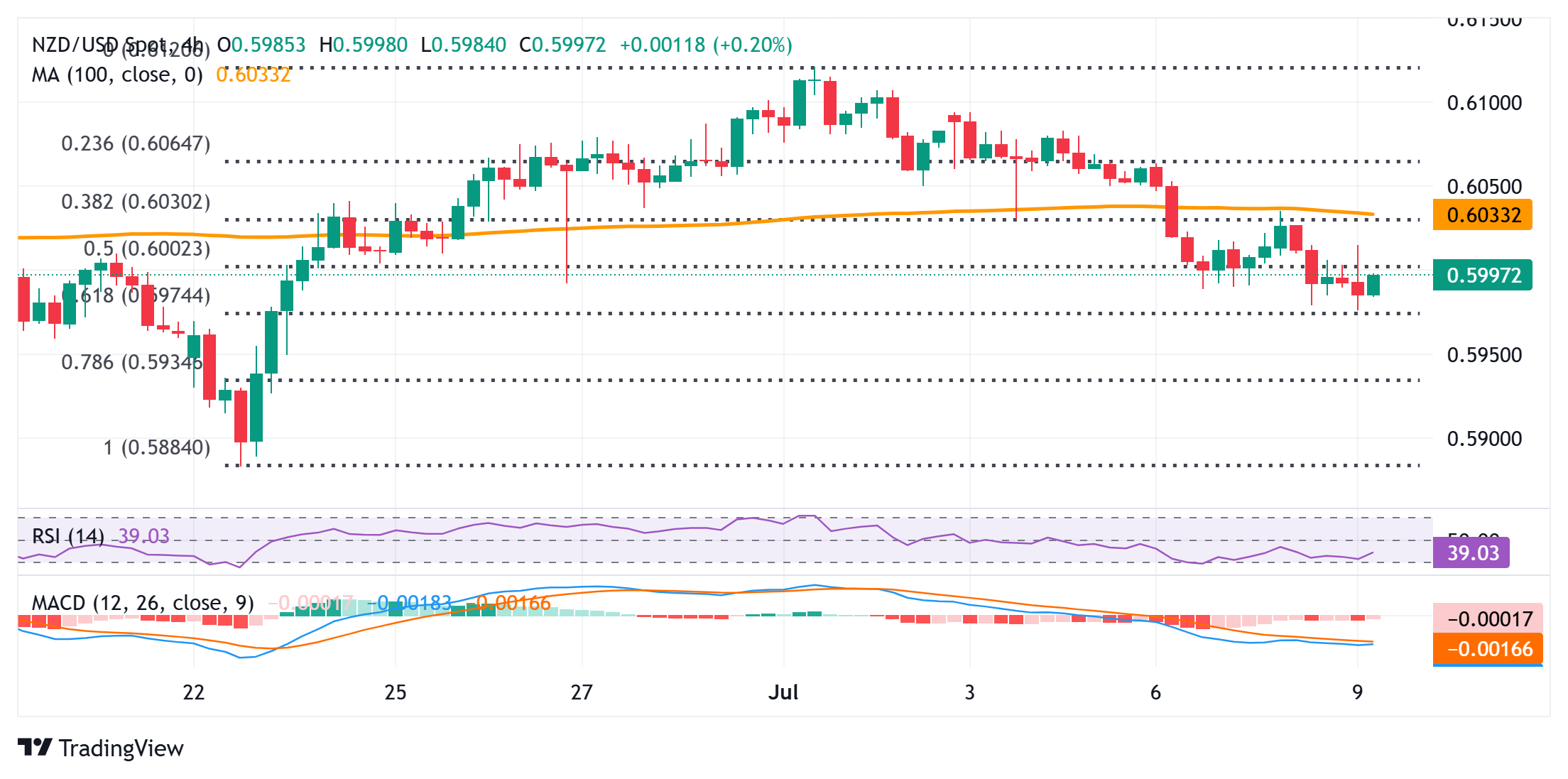Created
: 2025.07.09














![]() 2025.07.09 13:39
2025.07.09 13:39
The NZD/USD pair fades an intraday spike to the 0.6015 area that followed the Reserve Bank of New Zealand's (RBNZ) widely expected decision to hold rates steady and retests a two-week low during the Asian session on Wednesday. Spot prices currently trade below the 0.6000 psychological mark and seem vulnerable to slide further amid a broadly stronger US Dollar (USD).
The USD Index (DXY), which tracks the Greenback against a basket of currencies, remains well supported by expectations that higher US tariffs would underpin inflation and allow the Federal Reserve (Fed) to stick to its wait-and-see approach. Adding to this, concerns about the economic fallout from US President Donald Trump's trade policies weigh on investors' sentiment. This further benefits the safe-haven buck and acts as a headwind for the risk-sensitive Kiwi.
From a technical perspective, the NZD/USD pair's overnight breakdown below the 100-period Simple Moving Average (SMA) on the 4-hour chart was seen as a key trigger for bearish traders. Moreover, negative oscillators on hourly/daily charts suggest that the path of least resistance for spot prices is to the downside and back the case for an extension of the recent corrective slide from the 0.6120 area, or the highest level since October 2024 touched earlier this month.
However, it will still be prudent to wait for some follow-through selling below the 61.8% Fibonacci retracement level of the June-July rally, around the 0.5970 area, before positioning for deeper losses. The NZD/USD pair might then accelerate the fall to the 0.5935 intermediate support before eventually dropping to the 0.5900 round figure and June monthly swing low, around the 0.5880 region.
On the flip side, attempted recovery might now confront some resistance near the 0.6025 area (50% retracement level), above which the NZD/USD pair could climb to the 0.6060 region, or the 38.2% Fibo. retracement level. The subsequent move up could allow spot prices to reclaim the 0.6100 mark and retest the year-to-date peak, around the 0.6120 zone. A sustained move beyond the latter would be seen as a fresh trigger for bulls and pave the way for additional gains.

The New Zealand Dollar (NZD), also known as the Kiwi, is a well-known traded currency among investors. Its value is broadly determined by the health of the New Zealand economy and the country's central bank policy. Still, there are some unique particularities that also can make NZD move. The performance of the Chinese economy tends to move the Kiwi because China is New Zealand's biggest trading partner. Bad news for the Chinese economy likely means less New Zealand exports to the country, hitting the economy and thus its currency. Another factor moving NZD is dairy prices as the dairy industry is New Zealand's main export. High dairy prices boost export income, contributing positively to the economy and thus to the NZD.
The Reserve Bank of New Zealand (RBNZ) aims to achieve and maintain an inflation rate between 1% and 3% over the medium term, with a focus to keep it near the 2% mid-point. To this end, the bank sets an appropriate level of interest rates. When inflation is too high, the RBNZ will increase interest rates to cool the economy, but the move will also make bond yields higher, increasing investors' appeal to invest in the country and thus boosting NZD. On the contrary, lower interest rates tend to weaken NZD. The so-called rate differential, or how rates in New Zealand are or are expected to be compared to the ones set by the US Federal Reserve, can also play a key role in moving the NZD/USD pair.
Macroeconomic data releases in New Zealand are key to assess the state of the economy and can impact the New Zealand Dollar's (NZD) valuation. A strong economy, based on high economic growth, low unemployment and high confidence is good for NZD. High economic growth attracts foreign investment and may encourage the Reserve Bank of New Zealand to increase interest rates, if this economic strength comes together with elevated inflation. Conversely, if economic data is weak, NZD is likely to depreciate.
The New Zealand Dollar (NZD) tends to strengthen during risk-on periods, or when investors perceive that broader market risks are low and are optimistic about growth. This tends to lead to a more favorable outlook for commodities and so-called 'commodity currencies' such as the Kiwi. Conversely, NZD tends to weaken at times of market turbulence or economic uncertainty as investors tend to sell higher-risk assets and flee to the more-stable safe havens.
![]()
Created
: 2025.07.09
![]()
Last updated
: 2025.07.09

FXStreet is a forex information website, delivering market analysis and news articles 24/7.
It features a number of articles contributed by well-known analysts, in addition to the ones by its editorial team.
Founded in 2000 by Francesc Riverola, a Spanish economist, it has grown to become a world-renowned information website.
We hope you find this article useful. Any comments or suggestions will be greatly appreciated.
We are also looking for writers with extensive experience in forex and crypto to join us.
please contact us at [email protected].
Disclaimer:
All information and content provided on this website is provided for informational purposes only and is not intended to solicit any investment. Although all efforts are made in order to ensure that the information is correct, no guarantee is provided for the accuracy of any content on this website. Any decision made shall be the responsibility of the investor and Myforex does not take any responsibility whatsoever regarding the use of any information provided herein.
The content provided on this website belongs to Myforex and, where stated, the relevant licensors. All rights are reserved by Myforex and the relevant licensors, and no content of this website, whether in full or in part, shall be copied or displayed elsewhere without the explicit written permission of the relevant copyright holder. If you wish to use any part of the content provided on this website, please ensure that you contact Myforex.
Myforex uses cookies to improve the convenience and functionality of this website. This website may include cookies not only by us but also by third parties (advertisers, log analysts, etc.) for the purpose of tracking the activities of users. Cookie policy